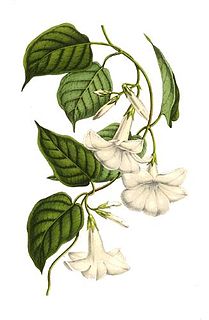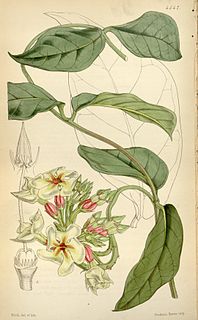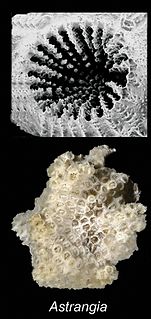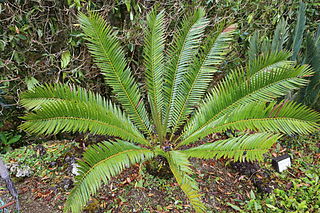
Herring are forage fish, mostly belonging to the family Clupeidae.

Apocynaceae is a family of flowering plants that includes trees, shrubs, herbs, stem succulents, and vines, commonly known as the dogbane family, because some taxa were used as dog poison. Members of the family are native to the European, Asian, African, Australian, and American tropics or subtropics, with some temperate members. The former family Asclepiadaceae is considered a subfamily of Apocynaceae and contains 348 genera. A list of Apocynaceae genera may be found here.

Mandevilla is a genus of tropical and subtropical flowering vines belonging to the family Apocynaceae. It was first described as a genus in 1840. A common name is rocktrumpet.

Mandevilla laxa, commonly known as Chilean jasmine, is an ornamental plant in the genus Mandevilla of family Apocynaceae.
Oscaecilia equatorialis is a species of caecilian in the family Caeciliidae. It is endemic to Ecuador. Its natural habitats are subtropical or tropical moist lowland forests, plantations, rural gardens, and heavily degraded former forest.
Afrixalus equatorialis, also known as the Congo banana frog, is a species of frog in the family Hyperoliidae. It is found in the central parts of the Congo Basin in the Democratic Republic of the Congo and southeastern Cameroon, and is likely to be found in the Republic of the Congo and the Central African Republic too. It might be conspecific with Afrixalus nigeriensis and is closely related to Afrixalus leucostictus.
Afrixalus leucostictus is a species of frog in the family Hyperoliidae. It is endemic to eastern and central Democratic Republic of the Congo. Its relationship with Afrixalus equatorialis is not fully understood. Common names Makese banana frog and speckled spiny reed frog have been proposed for it.

Mandevilla splendens, the shining mandevilla, is a species of flowering plant in the family Apocynaceae. It is an evergreen vine, native to Brazil.

Mandevilla boliviensis is a species of flowering plant in the dogbane family Apocynaceae, native to a region ranging from Costa Rica south to Bolivia and Brazil. Common names include white mandevilla and white dipladenia.

Mandevilla sanderi, the Brazilian jasmine, is a vine belonging to the genus Mandevilla. Grown as an ornamental plant, the species is endemic to the State of Rio de Janeiro in Brazil. It is a rapidly growing, creeping, perennial plant, pruning shoots about 60 cm per year.
Mandevilla dodsonii is a species of plant in the family Apocynaceae. It is endemic to Ecuador. Its natural habitat is subtropical or tropical moist lowland forests. It is threatened by habitat loss.
Mandevilla jamesonii is a species of plant in the family Apocynaceae. It is endemic to Ecuador. Its natural habitat is subtropical or tropical moist montane forests. It is threatened by habitat loss.

Acraea equatorialis is a butterfly in the family Nymphalidae. It is found in Uganda, Kenya and Tanzania.
Apterichtus equatorialis, the finless eel or equatorial eel, is a species of snake eel native to the eastern Pacific Ocean, from the Gulf of California to Panama and around the Galapagos Islands. This species can be found at depths of from 106 to 125 metres inhabiting areas with bottoms of sand or mud. This species can reach a length of 27 centimetres (11 in) TL.

Mesechites is a genus of plants in the family Apocynaceae first described as a genus in 1860. It is native to Mexico, Central America, South America, and the West Indies.
- Mesechites acuminatus Müll.Arg. - Peru
- Mesechites angustifolius(Poir.) Miers - Hispaniola
- Mesechites citrifolius(Kunth) Woodson - Colombia
- Mesechites mansoanus(A.DC.) Woodson - Paraguay, Brazil
- Mesechites minimus(Britton & P.Wilson) Woodson - Cuba
- Mesechites repens(Jacq.) Miers - Hispaniola, Navassa Island, Jamaica
- Mesechites roseus(A.DC.) Miers - Cuba
- Mesechites trifidus(Jacq.) Müll.Arg. - widespread from Tamaulipas in NE Mexico south to Paraguay + N Argentina
- Mesechites andrieuxii(Müll.Arg.) Miers = Mandevilla convolvulacea(A.DC.) Hemsl.
- Mesechites angustatusMiers = Mandevilla benthamii(A.DC.) K.Schum.
- Mesechites brownei(A.DC.) Miers = Mandevilla torosa(Jacq.) Woodson
- Mesechites dichotomus(Kunth) Miers = Laubertia boissieriA.DC.
- Mesechites guayaquilensisMiers = Mandevilla subsagittata(Ruiz & Pav.) Woodson
- Mesechites guianensis(A.DC.) Miers = Mandevilla rugellosa(Rich.) L.Allorge
- Mesechites hastatusMiers = Mandevilla subsagittata(Ruiz & Pav.) Woodson
- Mesechites hirtellulusMiers = Mandevilla oaxacana(A.DC.) Hemsl.
- Mesechites hirtellus(Kunth) Miers = Mandevilla subsagittata(Ruiz & Pav.) Woodson
- Mesechites jasminiflorus(M.Martens & Galeotti) Miers = Mandevilla subsagittata(Ruiz & Pav.) Woodson
- Mesechites lanceolatus(R.Br.) Miers = Parsonsia lanceolataR.Br.
- Mesechites oaxacanus(A.DC.) Miers = Mandevilla oaxacana(A.DC.) Hemsl.
- Mesechites ovalis(Ruiz & Pav. ex Markgr.) Pichon = Allomarkgrafia ovalis(Ruiz & Pav. ex Markgr.) Woodson
- Mesechites plumeriiflorus(Woodson) Pichon = Allomarkgrafia plumeriifloraWoodson
- Mesechites siphiliticus(L.f.) Lemée = Tabernaemontana siphilitica(L.f.) Leeuwenb.
- Mesechites subcarnosus(Benth.) Miers = Mandevilla subcarnosa(Benth.) Woodson
- Mesechites sulphureus(Vell.) Müll.Arg. = Prestonia coalita(Vell.) Woodson
- Mesechites torulosus(L.) Miers =Mandevilla torosa(Jacq.) Woodson

Temnadenia is a genus of flowering plants in the family Apocynaceae, first described as a genus in 1878. It is native to South America.
- Temnadenia annularis = Prestonia annularis
- Temnadenia cordata = Mandevilla oaxacana
- Temnadenia corrugulata = Prestonia solanifolia
- Temnadenia glaucescens = Mandevilla oaxacana
- Temnadenia lasiocarpa = Mandevilla hirsuta
- Temnadenia leptoloba = Prestonia quinquangularis
- Temnadenia lobbiana = Mandevilla hirsuta
- Temnadenia meyeri = Macropharynx meyeri
- Temnadenia palustris = Mandevilla hirsuta
- Temnadenia parviflora = Prestonia parviflora
- Temnadenia quinquangularis = Prestonia quinquangularis
- Temnadenia riedelii = Prestonia riedelii
- Temnadenia secundiflora = Mandevilla subsagittata
- Temnadenia semidigyna = Echites semidigynus
- Temnadenia solanifolia = Prestonia solanifolia
- Temnadenia tenuicula = Prestonia solanifolia
- Temnadenia tomentosa = Mandevilla hirsuta
- Temnadenia xanthostoma = Mandevilla coccinea
Angadenia is a genus of plants in the family Apocynaceae first described as a genus in 1878. It is native to Florida and the West Indies.
- Angadenia berteroi(A.DC.) Miers - Florida, Bahamas, Cuba, Hispaniola, Turks & Caicos Islands
- Angadenia lindeniana(Müll.Arg.) Miers - Cuba, Hispaniola, Jamaica

Astrangia is a genus of stony corals in the family Rhizangiidae. Members of this genus are non-reef building corals and are found in the Atlantic and Indo-Pacific Oceans. They are solitary corals with large polyps and are found in clumps. They reproduce from stolons. The corallites are small with simple toothed septa.

Encephalartos equatorialis is a species of cycad that is found on two granite hills on the eastern shore of Thurston Bay, Lake Victoria, Uganda at elevations up to 1000 meters.












